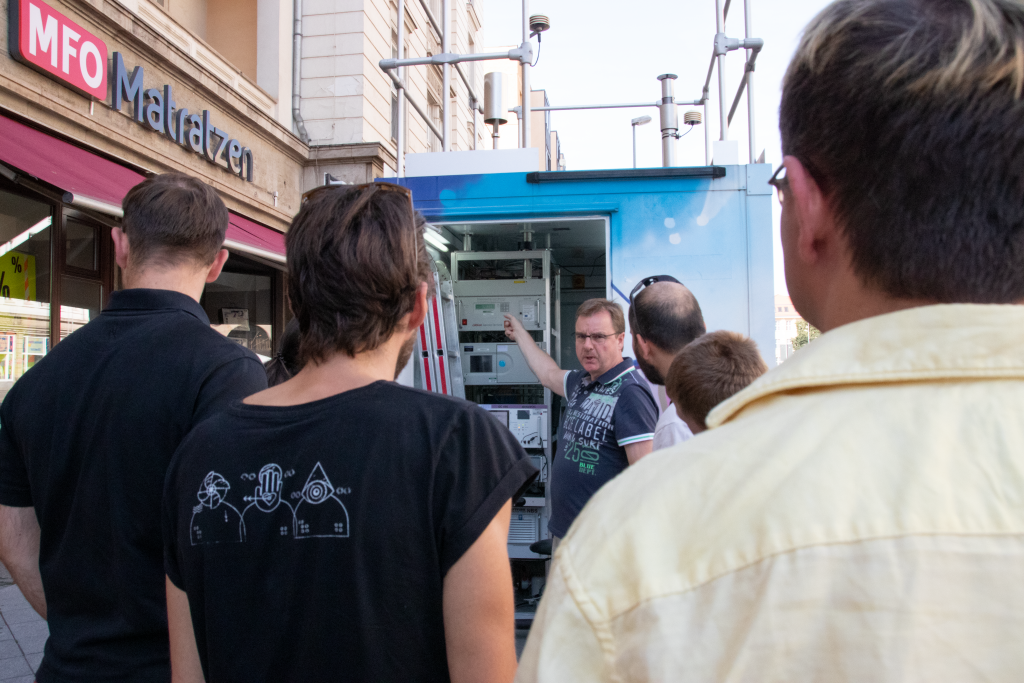Citizen Participation
Citizen Participation aims to understand how we can create citizen awareness and behavioral changes around air pollution using a Critical Design Science Approach and explain which types of citizen participation are suitable to communicate the topic.

The conception and development of a public awareness installation contributes to the participation of citizens and education on the topic of air pollution. The conception takes place in a design thinking process, in which examples of information installations in the context of climate-related environmental factors are collected and analyzed worldwide in the first step. In the concept phase, different communication strategies are tested and discussed with designers, in order to effectively and educationally convey the causes and consequences of air pollution to the public. User scenarios for the information installation in public spaces serve as requirements analysis for implementation options, technology use, interface design, data generation, possible access barriers, and legal requirements or location-specifics.
The ideation also involves exchanging ideas with experts in the field of participation, citizen participation, and collaboration. Together, a citizen dialogue is planned – selected citizens in Magdeburg are invited to participate in a one-day workshop on the topic of air pollution. In addition to scientific inputs and educational work to address the participants thematically, opinions, desires, and needs for actively combating air pollution are obtained and prioritized. In the workshops, it was determined which information and data are relevant and comprehensible for citizens. The results form the basis for the design of the social intervention. The product design for the public awareness installation is first implemented as a low-fidelity prototype in the first iteration.
For this purpose, sketches are generated, consultations are conducted, 3D models are possibly created, technology and materials are procured, creative coding and physical computing methods are applied for technical implementation, and organizational tasks for implementing the installation are processed. In the design phase, a project-related course will be conducted with students from the industrial and interaction design departments in Magdeburg and computer science students in Skopje, hybrid, who will participate conceptually in the development of the overall installation and intervention. In addition to online events throughout the semester with both student groups, an excursion to Skopje will be planned for selected students. Together with students in Skopje, a critical design workshop will be initiated, where speculative future scenarios on the topic of air pollution and solutions will be created. Theory units and methods for speculative design will be prepared for the workshop, teaching materials will be generated, and digital exchange formats will be created (e.g. Miro Board, cloud solutions, digital onboarding, research, and implementation of intercultural higher education). The results will be compiled and digitally published in the media (for example, in the form of a future catalog).
A first prototype of the Public Awareness Installation will be set up in Magdeburg and tested at a citizen meeting event. The evaluation will be accompanied and analyzed by the Macedonian social scientist. The results provide important insights regarding the need for adjustments to the installation and the intervention process. The revised intervention will take place in Skopje 3 months later. This will allow for conclusions to be drawn regarding cultural influences on participation and educational methods. The collected feedback will enable targeted redesign and the final planning of a participation strategy, as well as the technical implementation of the Public Awareness Installation. A final user and expert workshop will be held, inviting political decision-makers to a public citizen dialogue. The final design of the Public Awareness (Information) Installation will be mounted and presented in a fixed location. Political decision-makers will discuss necessary measures in terms of raising awareness, prevention, and realignment of climate policy; citizens will be provided with a platform for exchange and an information source through public data visualization. This includes social interventions such as the implementation of virtual reality scenarios (VR glasses), which visualize the consequences of current climate policies as learning applications.
BIBLIOGRAPHY
Elliott, B., & Moses, E. (2022). Clean Air Action: Applications of Citizen Science to Identify and Address Air Pollution Emission Sources.
Bonney, R., Cooper, C. B., Dickinson, J., Kelling, S., Phillips, T., Rosenberg, K. V., & Shirk, J. (2009). Citizen science: a developing tool for expanding science knowledge and scientific literacy. BioScience, 59(11), 977-984.

